Diego Rivera
chronology
-
Event
-
Jose Diego Rivera and his twin brother, Jose Carlos Rivera, are born in Guanajuato, Mexico, eldest sons of Diego Rivera and Maria del Pilar Barrientos.
-
Jose Carlos Rivera, Diego's twin dies.
-
Maria del Pilar, Diego's sister, is born in Guanajuato.
-
Diego's mother takes Diego and his sister, Maria, and moves to Mexico City. Diego Rivera Senior soon joins the family there.
-
Attends night classes at the San Carlos Academy of Fine Arts.
-
Attends full time day classes and graduates from San Carlos Academy.
-
Rivera exhibits for the first time, showing twenty-six works at the annual Exhibition of the San Carlos Academy. Diego, with his father's political connections, travels to Veracruz to visit Governor Dehesa, who grants him a scholarship which finances his travels and studies in Europe.
-
Arrives in Santander, Spain aboard the ship, Alfonso XIII, then travels by train to Madrid.
-
Travels throughout Spain, studies Old Masters: Goya, Velaquez, Brueghel, El Greco; paints canvases which are sent home to his Mexican patrons and sells his other works to Spanish art galleries.
-
Travels to Paris and beyond, touring throughout Belgium, studying Flemish Masters; then on to London. In Bruges, Belgium, he meets a Russian émigré artist, Angeline Beloff, who goes back to Paris with him and becomes his companion for the next ten years.
-
Exhibits six of his paintings at the Society of Independent Artists in Paris. Takes one of his paintings, House on the Bridge, off the wall and exhibits it in the Salon de la Societe des Artistes Francais, a juried show.
-
Sails home to Mexico to participate in President Porfirio Diaz's political Mexican Art Exhibition.
-
Diego arrives in Veracruz, Mexico, with armloads of canvases, greeted by his father and sister.
-
Exhibits thirty-five oils, two etchings and eight drawings in the San Carlos Academy Exhibit, a show mounted by Mexican artists, not Spanish, for the Porfirian centennial celebration. Witnesses the outbreak of the Mexican Revolution, that will last from 1910 to 1920.
-
Diego returns to Paris. In April, Angeline Beloff returns from Russia to meet him there. Angeline becomes his common-law wife and they move together to 52 avenue du Maine, Montparnasse. Enters two large canvases of Iztaccihuatl in the Salon d'Automne In the summer they travel to Normandy and in the winter they visit Barcelona. There he paints large canvases of the surrounding Catalonian mountains in his first modernistic style.
-
Meets Piet Mondrian who lives in the same building and who is beginning to paint his trees in the Cubist style. Rivera paints a watercolor, Trees, revealing the first Cubist influence in his work. In the spring, he and Angeline travel to Toledo, Spain, with the specific purpose to study El Greco. They live at 7 Calle del Angel that they use many times on their trips back and forth from Paris. He paints large canvases such as The Old Ones and View of Toledo. Exhibits two of his Catalonian paintings in the 1912 spring Salon. Moves with Angeline to 26 rue du Depart, Montparnasse, where they live for the next six years. Most other artists had also moved from Montmartre by this time, preferring to live on the more open avenues of Montparnasse.
-
Completely immersed in Cubism by the beginning of this year and paints in this genre for the next four and a half years. Meets and becomes a good friend of Modigliani, who paints three Rivera portraits.
In February, Mexican President-Elect Madero, is murdered, suddenly ending Rivera's government subsidy.
-
Picasso sends for Rivera to come to lunch at his home. Diego is not only captivated by Pablo but is even more intrigued by his large collection of Rousseau paintings. Picasso and Rivera become great friends and Cubist painting compatriots over the next four years.
First one-man exhibit at the Berthe Weill Gallery in April. In the summer, he and Angeline, with artist friends, embark on a walking tour of Spain. In Mallorca he is caught up in the outbreak of the First World War. He and Angeline sail to Barcelona, then take the train to Madrid, where they remain for almost a year. -
In the summer, Diego returns to Paris alone, leaving Angeline in Madrid for two months.
He makes a contract with an art dealer, Leonce Rosenberg, to provide a quantity of paintings per month, to be paid according to subject and size. He now has the money to send for Angeline to travel back to Paris. While Angeline is away, he again meets Russian artist, Marevna Vorobyov-Stebelska, and she becomes his mistress. All Salons are closed due to the war so there are no exhibits in Paris. -
Angeline becomes pregnant and they have a baby boy, Diego Junior, born in August.
Exhibits at the Modern Gallery, New York City. -
Exhibits and sells his paintings through Rosenberg's gallery, the Galerie L'Effort Moderne, Paris.
He has a serious disagreement with Picasso and abandons Cubism forever and returns to naturalistic imagery.
In the winter, his son, Diego Junior, dies. -
Moves with Angeline to the Champ-de-Mars. He is painting now under the influence of Rousseau and Cezanne.
-
Daughter, Marika, born in Paris to Marevna Vorobyov-Stebelska.
The new Mexican president, Alvaro Obregon, summons artists home to paint nationalistic murals.
Meets with David Alfaro Siqueiros and discusses his plans to drastically change the traditional French and Spanish art of Mexico. -
Detours to Italy to study the artistic techniques of fresco paintings. Returns briefly to Paris to make plans to return to Mexico.
-
In June arrives back home in Mexico.
In December, begins his mural, Creation, in the Simon Bolivar Amphitheatre of the National Preparatory School.
Near the end of the year, his father, Diego Rivera Senior, dies. -
Co-founds the Union of Revolutionary Painters, Sculptors, and Graphic Artists.
Becomes an official member of the Mexican Communist Party.
Meets and marries his first wife, Guadalupe Marin, in Catholic church. -
Begins his greatest Mexican mural, consisting of 128 individual panels, in the Ministry of Education building. This mural becomes one of the most lasting triumphs of 20th Century art.
-
Daughter, Guadalupe, is born.
-
While still working on the Ministry of Education Cycle, begins painting a major cycle of frescos at the National School of Agriculture at Chapingo.
-
Daughter, Ruth, is born.
-
In the fall, invited to the Soviet Union to participate in the celebration of the Tenth Anniversary of the Russian October Revolution. In September, visits museums in Berlin then takes the train to Moscow. Lupe gets a divorce and Rivera stays in Soviet Union for eight months.

La Era 1904

Self-Portrait 1907 Night in Avila 1907 The House of Vizcaya 1907

Head of a Breton Woman 1910

View of Toledo 1912 View of Arcueil

Landscape at Toledo 1913 Still Life 1913 Woman at a Well 1913 Portrait of Oscar Miestchaninoff The Adoration of the Virgin 1913

La Tour Eiffel 1914 Portrait of Two Women 1914 Sailor at Breakfast (Marinero Almorzando) 1914 Farmhouse 1914
.jpg)
Spanish Still Life 1915 The Architect, Jesus T. Acevedo 1915 Martin Luis Guzman 1915

The Telegraph Pole 1916 Motherhood Angeline and the Child Diego 1916
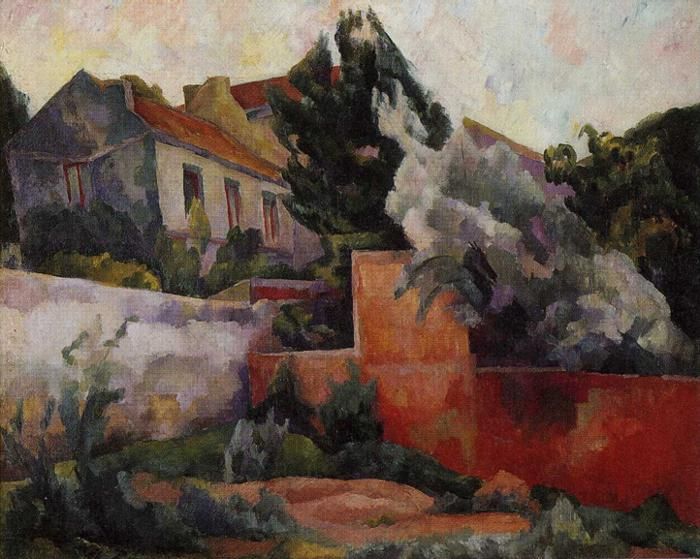
The Outskirts of Paris 1918 Still Life 1918

Bather of Tehuantepec 1923
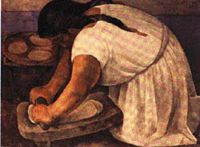
La Molendera 1924
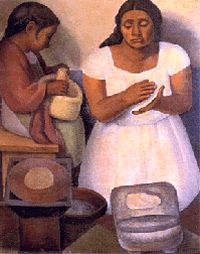
The Tortilla Maker 1926 La Siesta 1926
-
Event
-
Returns to Mexico in June.
Finishes the mural on the top floor of the Ministry of Education building.
Finishes frescos at Chapingo.
Meets Mexican artist, Frida Kahlo.
-
Mexican President-Elect Obregon is assassinated.
-
Diego and Frida married in legal secular wedding ceremony.
-
Paints mural in the stairwell at the National Palace and one at the Ministry of Health.
Commissioned by the U.S. ambassador in Mexico to paint a mural at the Palace of Cortes in Cuenavaca.
Appointed Director of the upper school of the San Carlos Academy of Art, from which he had graduated, but is soon dismissed after attempting to make major changes in the art curriculum.
Expelled from the Communist Party. -
Commissioned to paint a mural in the stairwell of the San Francisco Stock Exchange Luncheon Club and another at the California School of Fine Arts.
-
Produces the new Museum of Modern Art's second one-man show in New York City, the first was by Matisse. His retrospective sets a new attendance record for the museum.
-
At the request of Edsel Ford, begins to paint multiple panels depicting the 20th Century automobile industry at the Detroit Institute of Arts.
Designs sets and costumes for the Carlos Chavez's ballet, Horse Power. -
Arrives in New York City with Frida. Begins to paint a mural at the new Rockefeller Center. In April, he is suspended from the project and several months later, the entire mural is destroyed.
-
Diego and Frida return to Mexico to a new home and studio that he has built for them in the San Angel suburb of Mexico City.
-
Executes the mural originally planned for Rockefeller Center in a smaller scale at the Palace of Fine Arts in Mexico City.
-
Completes the murals in the stairwell of the National Palace.
-
Paints four frescos in Hotel Reforma Giro Bar, Mexico City, with strong anti-government imagery. They are later removed from the walls.
-
The Russian exile, Leon Trotsky and his wife, Natalia Sedova, arrive in Mexico, politically arranged by Rivera with Mexican President Cardenas. Rivera provides a home for them at Frida's family Blue House in the Coyoacan suburb of Mexico City which he fortifies for their safety.
-
Andre Breton, the French surrealistic poet, and his wife stay as houseguests with Diego and Frida. Breton writes a manifesto about art and revolution with Trotsky.
-
Rivera and Trotsky separate after arguments about Marxist ideology.
Diego and Frida agree on a marriage separation. -
Paints "Pan American Unity" a mural comprising 10 panels, in front of a live audience attending the festivities at the Golden Gate International Exposition on Treasure Island, San Francisco. The mural resides at City College of San Francisco.
He invites Frida to join him in the United States. -
Diego and Frida remarry on his 54th birthday.
-
Returns to Mexico, paints large quantity of easel art, rendering portraits of both the rich and the poor.
Paints frescos in the courtyard of the National Palace.
Plans interior construction of his Anahuacalli Museum in the Blue House to exhibit his vast collection of Pre-Columbian sculpture. -
Paints two murals for the National Institute of Cardiology.
Becomes one of the first members of the National College.
Holds conferences on art, science and politics.
Appointed a professor at La Esmeralda College of Art. -
Commissioned to paint large sized mural at the new Hotel del Prado.
Paints his last masterpiece, Dream of a Sunday Afternoon in Alameda Park, in the restaurant of the hotel. -
Forms the National Institute of Fine Arts' Commission for Mural Painting in partnership with Jose Clemente Orozco and David Alfaro Siqueiros.
-
Fiftieth Anniversary of his artistic career celebrated by a retrospective exhibition at the Palace of Fine Arts.
-
Awarded the National Prize for Plastic Arts at the Venice Biennale.
Designs sets for Jose Revueltas' stage play El cuadrante de la soledad. -
Paints underwater murals in polystyrene in the "Carcamo del Rio Lerma" waterworks in Chapultepec Park in Mexico City and executes the stone mosaic in the well at the entrance.
-
Paints a movable mural for the exhibition Twenty Centuries of Mexican Art which travels around Europe. The inclusion of his portraits of Stalin and Mao Tse-tung results in the removal of the mural from the exhibition. It is sent to the People's Republic of China.
-
Produces a glass mosaic mural on the facade of the Teatro de los Insurgentes.
Finishes his work on the front of the Olympic Stadium at Mexico University.
Paints a mural in La Raza Hospital for the Institute of Social Security. -
Participates in a solidarity rally for the president of Guatemala, Jacoba Arbenz.
In September, he is officially accepted back into the Communist Party. -
Frida Kahlo, Diego's wife, dies.
-
Marries his art dealer, Emma Hurtado, in July.
In July, Diego is diagnosed with cancer.
Entrusts the Blue House which houses his Anahuacalli Museum of Pre-Columbian sculpture to the Mexican people.
Travels to the Soviet Union to seek medical attention. -
Diego Rivera, painting in his studio, dies in San Angel, Mexico.

Dance in Tehuantepec 1928
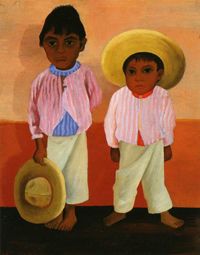
My Godfathers Sons Portrait of Modesto and Jesus 1930 Zapata 1930
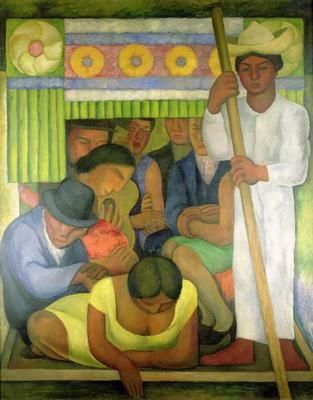
The Flowered Canoe 1931 The Feast of Santa Anita 1931
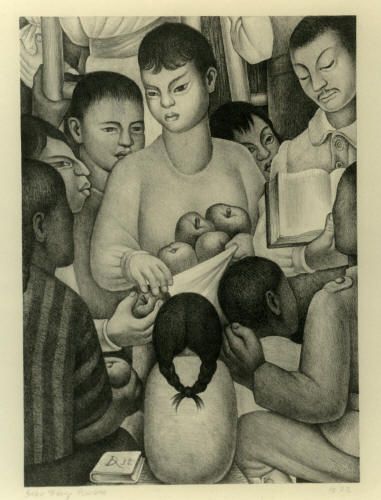
The Fruits of Labor 1932 Boy and Dog 1932

Photograph of mural, Man, Controller of the Universe, in working progress, at Rockefeller Center before it was destroyed

Indian Woman 1935

The Pinole Seller 1936
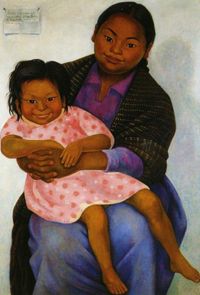
Portrait of Madesta and Inesita 1939

Cargo Man 1941 Pair of Indians
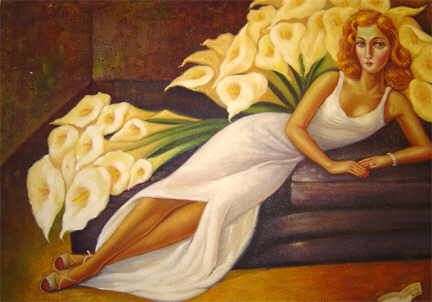
Portrait of Natasha Gellman 1943
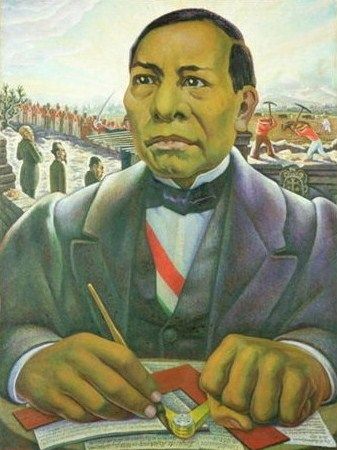
Picture 86 Portrait of Benito Juarez 1948

Portrait of Sra Dona Elena Flores de Carrillo 1953
.jpg)
Moscow May Day Parade 1955

Evening at Acapulco 1956 Self-Portrait 1949
